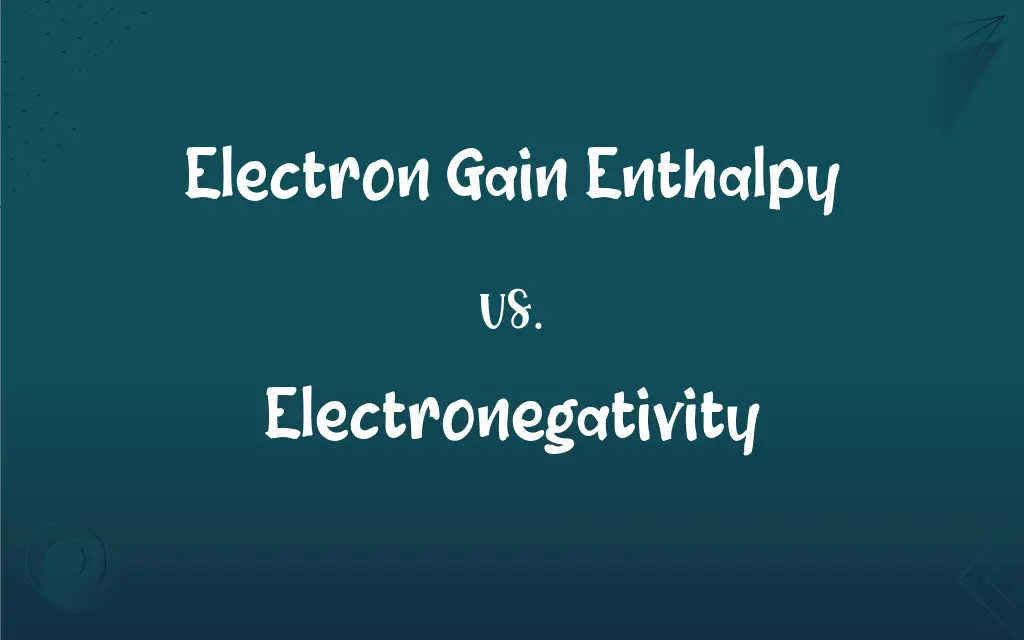Electron Gain Enthalpy vs. Electronegativity: What's the Difference?
Edited by Aimie Carlson || By Harlon Moss || Published on January 9, 2024
Electron gain enthalpy measures the energy change when an electron is added to an atom, while electronegativity is the atom's tendency to attract electrons in a bond.

Key Differences
Electron gain enthalpy refers to the energy released or absorbed when an atom gains an electron. Electronegativity, in contrast, is a measure of how strongly an atom attracts electrons when forming a chemical bond.
A negative electron gain enthalpy indicates energy release, common in nonmetals. High electronegativity means an atom strongly attracts electrons, seen in elements like fluorine.
Electron gain enthalpy can vary widely among elements. Electronegativity, on the other hand, follows a more predictable trend across the periodic table, increasing across periods and decreasing down groups.
Electron gain enthalpy is crucial in predicting the reactivity of anions. Electronegativity is key in determining the nature of chemical bonds, influencing whether they are ionic or covalent.
Elements with high electron gain enthalpy are often good oxidizing agents. Elements with high electronegativity are more likely to form negative ions in compounds.
ADVERTISEMENT
Comparison Chart
Definition
Energy change when an atom gains an electron.
Tendency of an atom to attract electrons in a bond.
Measurement
Expressed in kilojoules per mole (kJ/mol).
Dimensionless, often using the Pauling scale.
Trend in Periodic Table
Varies among elements, negative for nonmetals.
Increases across periods, decreases down groups.
Influence on Chemical Bonds
Affects anion reactivity and formation.
Determines bond type (ionic/covalent) and polarity.
Role in Chemical Reactions
Indicates oxidizing ability of elements.
Influences bond strength and molecular structure.
ADVERTISEMENT
Electron Gain Enthalpy and Electronegativity Definitions
Electron Gain Enthalpy
Electron gain enthalpy varies across the periodic table.
Metals typically have lower electron gain enthalpy than nonmetals.
Electronegativity
It determines the polarity of chemical bonds.
High electronegativity differences lead to polar bonds.
Electron Gain Enthalpy
Electron gain enthalpy is the energy change during electron addition to an atom.
Chlorine has a high negative electron gain enthalpy, releasing energy upon gaining an electron.
Electronegativity
Electronegativity is the ability of an atom to attract electrons in a bond.
Fluorine has the highest electronegativity, attracting electrons strongly in bonds.
Electron Gain Enthalpy
It indicates how readily an atom accepts an electron.
Elements with low electron gain enthalpy are less likely to gain electrons.
Electronegativity
Electronegativity increases across a period and decreases down a group.
Electronegativity tends to be higher in nonmetals than in metals.
Electron Gain Enthalpy
Negative electron gain enthalpy signifies exothermic electron addition.
Oxygen has a negative electron gain enthalpy, indicating exothermic electron addition.
Electronegativity
Measured on various scales, like the Pauling scale.
The Pauling scale shows fluorine with the highest electronegativity value.
Electron Gain Enthalpy
It affects the formation and stability of anions.
High electron gain enthalpy in halogens makes them effective at forming stable anions.
Electronegativity
Affects the ionic or covalent nature of chemical bonds.
Elements with similar electronegativities form covalent bonds.
Electronegativity
(chemistry) The tendency, or a measure of the ability, of an atom or molecule to attract electrons when forming bonds.
Electronegativity
(chemistry) the tendency of an atom or radical to attract electrons in the formation of an ionic bond
FAQs
What does negative electron gain enthalpy mean?
It means energy is released when the atom gains an electron.
What is electron gain enthalpy?
It's the energy change when an electron is added to an isolated atom.
How is electron gain enthalpy measured?
It's measured in kilojoules per mole (kJ/mol).
What element has the highest electronegativity?
Fluorine has the highest electronegativity.
What is electronegativity?
Electronegativity is the tendency of an atom to attract bonding electrons.
Does a high electronegativity mean high electron gain enthalpy?
Not necessarily, as they relate to different aspects of electron interaction.
How is electronegativity measured?
It's measured on a dimensionless scale, like the Pauling scale.
Does electron gain enthalpy affect ion formation?
Yes, it influences the tendency of atoms to form anions.
Can electron gain enthalpy predict oxidizing ability?
Yes, elements with high electron gain enthalpy are often good oxidizers.
Can two elements have the same electron gain enthalpy?
Yes, but it's rare due to differences in atomic structures.
Why is fluorine the most electronegative element?
Due to its small size and high effective nuclear charge, fluorine strongly attracts electrons.
Are electronegativity and electron gain enthalpy related?
They are related concepts but measure different properties.
Do metals have high electron gain enthalpy?
Generally, metals have lower electron gain enthalpy than nonmetals.
Can electron gain enthalpy be zero?
Yes, for noble gases under standard conditions, it's effectively zero.
Does electronegativity affect bond type?
Yes, it influences whether bonds are ionic or covalent.
Can electron gain enthalpy predict molecular stability?
It contributes to understanding anion stability in molecules.
How does electron gain enthalpy change in a group?
It generally decreases down a group due to increasing atomic size and shielding effect.
How does electronegativity vary in the periodic table?
It increases across periods and decreases down groups.
Is electronegativity important in organic chemistry?
Yes, it's crucial for understanding bond polarity and reactions in organic molecules.
What factors affect electronegativity?
Atomic number and the distance between the nucleus and valence electrons affect it.
About Author
Written by
Harlon MossHarlon is a seasoned quality moderator and accomplished content writer for Difference Wiki. An alumnus of the prestigious University of California, he earned his degree in Computer Science. Leveraging his academic background, Harlon brings a meticulous and informed perspective to his work, ensuring content accuracy and excellence.
Edited by
Aimie CarlsonAimie Carlson, holding a master's degree in English literature, is a fervent English language enthusiast. She lends her writing talents to Difference Wiki, a prominent website that specializes in comparisons, offering readers insightful analyses that both captivate and inform.

































































